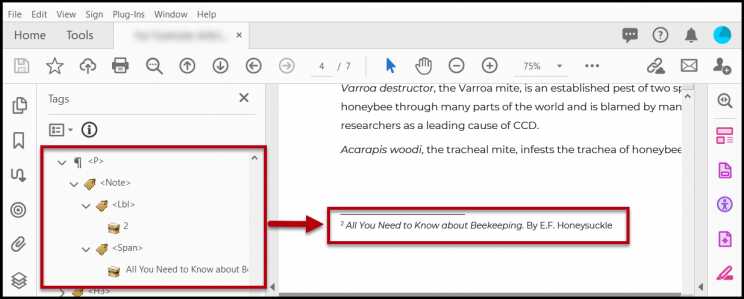A question that often comes up in our PDF remediation classes is, “how do you tag footnotes or endnotes?”
This article provides guidance on tagging and offers suggestions and options to consider when determining the tags’ reading order in the Tags tree.
Please note:
- The guidance and suggestions offered in this article are for version 1 of the PDF standard (ISO 32000) and version 1 of PDF/UA. These guidelines will change when version 2 of those standards is fully released, implemented and supported.
- We use “number” when discussing superscript characters, but you can use other characters like letters or symbols. Likewise, the main body of the document can be a paragraph, list or table, though we will primarily use paragraph in this article.
There are two separate components to tagging footnotes or endnotes.
The first part is the superscript number in the main body of the document. For footnotes, the second part is the note itself, which appears at the bottom of the page. Endnotes show up at the end of the document.
Part 1 – The Reference Tag
In each instance of a footnote or endnote, the superscript number is placed within a Reference tag. The screenshot below shows a Reference tag in the Tags tree with the number 2 inside it. The superscript number 2 is highlighted at the end of a paragraph in the physical view.

Notice that the Reference tag is in the Paragraph tag with the rest of the paragraph’s text.
Part 2 – The Note Tag
Tagging the note itself, what the reference points to, has several parts. A Note tag contains it all, but there may be sub-structures inside. Ordinarily, the number is placed in a Label (Lbl) tag. The text of the footnote is placed in a Span tag.
Of course, there are additional things to consider.
Various standards have different requirements for tagging Notes. For example, the WCAG standards (both 2.0 and 2.1) do not require Lbl or Span tag use inside the Note tags. PDF/UA requires the Lbl tag. The Span tag can help to keep things organized.
In the screenshot below, the Note tag is a child of a Paragraph tag. According to ISO 32000-1, Note tags are Inline-Level Structure Elements, so they need to go in a Block-Level element, like a P. However, according to PDF/UA, if its placement value is “Block,” then the Note tag does not need to be placed inside a P tag. The process of setting the placement is quick and easy with CommonLook PDF’s Fix Wizard.

PDF/UA requires a unique ID for each Note tag. Again, CommonLook PDF’s Fix Wizard accomplishes this more efficiently than in Acrobat alone.
Determining the Reading Order for Footnotes and Endnotes
When it comes to footnotes or endnotes, tagging the References and Notes is often the simple part. Determining the reading order often proves more challenging. Though your organization’s policies may provide guidance, oftentimes it comes down to the remediator’s choice. Here are some suggestions and things to consider:
- Place the Note tag in the Tags tree (in a P tag), immediately after the Paragraph tag that references it. When a list refers to a note, move the Note tag inside the LBody, placing it after the text in the LBody.
- The advantage of this choice is that it places the note text closer in the reading order to where it is referenced.
- If the same footnote is used to more than once in a document, do not use this option.
- Do not move Note tags inside TH cells in data tables. If a footnote is referenced in a table’s header cell, add the note in a Paragraph tag below the table in the Tags tree.
- Place the Note tag (in a P) as the last tag for the page where it appears in the physical view.
- Use this option if the same footnote is referred to multiple times on the page.
- Caution: If a paragraph or list item spans across multiple pages, do not break the Paragraph, LBody or List tag at the end of one page to insert the Note tag before the page break. Instead, move the Note tag after the Paragraph tag, even if it means the note appears on the following page.
- Endnotes: because endnotes occur at the end of the document, their Note tags should be placed in the Tags tree according to the endnote’s location in the physical view. Keep in mind proper nesting – there should be Paragraph tags as parents for the Note tags.
If the Footnote or Endnote Contains a Link
When the reference links to notes at the bottom of the page, or to the endnote, tag the Link inside the Reference tag. In turn, the Reference tag will live inside a Paragraph (or, perhaps, an LBody, for example). A properly structured Link tag contains both the text for the Link and the Annotation. In the screenshot below, the reference, Note 1, is linked to a footnote. The Reference tag contains a Link tag that includes the text, Note 1, and the Annotation.

What Screen Readers Do
Technically, Reference tags are for internal links within the document. When screen readers come across a Reference tag, they will say “link.”
Unfortunately, this happens even though the reference may not have a link.
Similarly, if the Reference tag contains an actual link, screen reader users will hear “Link, link”–once for the Reference and again for the Link tag.
This is a known issue with screen readers that will hopefully be addressed by their developers soon. In addition, some of this is to be corrected in the next version of the PDF standard.

